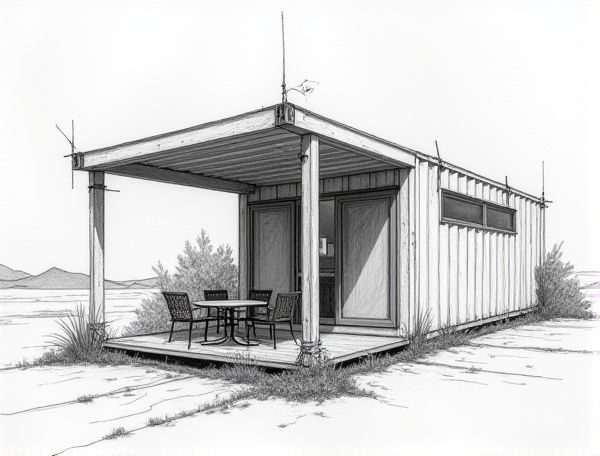
Photo illustration: Shipping container home design with hurricane strapping
Shipping container home design offers a durable and sustainable living solution, enhanced by incorporating hurricane strapping to secure the structure against extreme weather conditions. Explore the article to learn how this method boosts safety and resilience in your container-based home.
Introduction to Shipping Container Home Design
Shipping container home design offers a sustainable, cost-effective housing solution by repurposing steel containers into modern living spaces. Incorporating modular construction techniques, these homes provide flexibility in layout and scalability while minimizing environmental impact. Key design elements include insulation, ventilation, and structural reinforcement to ensure comfort and durability.
Benefits of Using Shipping Containers for Homes
Shipping container homes offer unparalleled durability due to their steel structure, ensuring long-lasting protection against harsh weather conditions. Their modular design allows for customizable and scalable living spaces, maximizing your home's functionality while reducing construction time and costs. Utilizing recycled containers supports eco-friendly building practices, contributing to sustainability and lowering your carbon footprint.
Understanding Hurricane Risks for Container Homes
Understanding hurricane risks for container homes involves assessing structural integrity against high winds and debris impact, as ISO standards emphasize reinforced steel construction and secure anchoring systems. You should prioritize elevated foundations and storm-resistant windows to enhance safety and minimize damage during hurricanes.
What is Hurricane Strapping?
Hurricane strapping is a crucial structural reinforcement technique using metal connectors that securely anchor a roof to the walls of a home, significantly enhancing resistance against high winds and storm damage. Engineered to comply with building codes in hurricane-prone regions, hurricane straps reduce the risk of roof uplift by distributing wind forces evenly across the building frame.
Key Materials Needed for Hurricane Strapping
Hurricane strapping requires galvanized steel straps known for their corrosion resistance and high tensile strength, ensuring structural stability during extreme weather. Stainless steel nails or screws are essential for securing the straps firmly to the wooden framing, preventing uplift and lateral movement. Adequate quantities of ring-shank nails enhance grip and durability, making the siding and roofing components more resilient against hurricane-force winds.
Design Principles for Hurricane-Resistant Container Homes
Incorporate reinforced steel frames and impact-resistant windows to enhance the structural integrity of your hurricane-resistant container home, ensuring it withstands extreme wind forces and flying debris. Elevate the foundation and integrate seamless waterproof seals to prevent water intrusion during storm surges and heavy rainfall, safeguarding your home's durability and your safety.
Step-by-Step Guide to Installing Hurricane Straps
Start by selecting high-quality hurricane straps rated for your region's wind speeds, then position them at critical structural points such as roof trusses, rafters, and wall studs to enhance wind resistance. Secure each strap using corrosion-resistant nails or screws, ensuring tight, flush fitting to maintain structural integrity during hurricanes.
Building Codes and Regulations for Hurricane Zones
Building codes and regulations in hurricane zones mandate reinforced roofing, impact-resistant windows, and elevated foundations to withstand extreme wind speeds and storm surges. Your home design must comply with these standards to ensure safety, reduce damage, and qualify for insurance in hurricane-prone areas.
Maintenance Tips for Hurricane-Proof Container Homes
Regular inspection of seals and reinforcements around windows, doors, and roof joints is essential to maintain hurricane-proof container homes. Applying weather-resistant coatings and rust-proof paints extends the durability of steel structures against harsh storm conditions. Clearing debris from drainage systems and securing loose exterior elements prevent water intrusion and structural damage during hurricanes.
Real-Life Examples of Hurricane-Strapped Container Homes
Hurricane-strapped container homes in coastal areas like Florida and Texas demonstrate exceptional resilience during extreme weather events, with multiple documented cases surviving Category 4 hurricanes without structural damage. These homes utilize heavy-duty steel straps and reinforced foundations to anchor containers securely, minimizing uplift and lateral movement caused by high winds. Innovations in container home design now incorporate hurricane straps as standard practice, significantly reducing repair costs and increasing occupant safety during storms.
 homedesy.com
homedesy.com